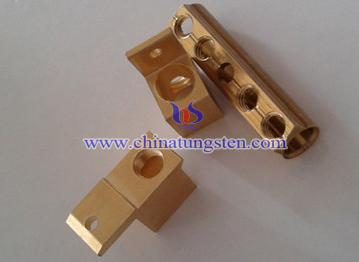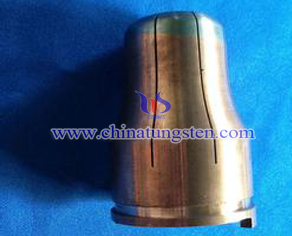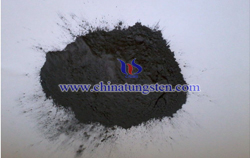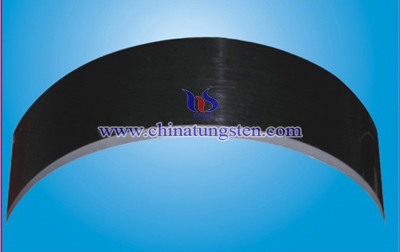Tungsten Heater and Tungsten Stranded Wire
- Details
- Category: Tungsten Information
- Published on Thursday, 23 June 2016 17:33
- Written by xuejiao
- Hits: 247
Tungsten stranded wire is a kind of strip tungsten products made of a certain specification of diameter of a number of tungsten wire, which is mainly used to produce tungsten heater. In the vacuum coating, tungsten wire cutter is a consumable material. Now it is widely used in kinescope, mirror, mobile phones and all kinds of plastic, metal and organic substrates and various accessories and other surface spraying industry.
As the main raw material of tungsten heater, the quality of tungsten stranded wire will directly affect the quality of tungsten heater which will have a greater impact on the coating effect. Therefore, surface of stranded tungsten coil should be glossy silver color without any visible contamination, no and there are no obvious cracks and oxidation glitches on the surface. Each twisted tungsten wires cannot have any breakage, and the spiral coil should have flexibility to a certain extent. The deviation of size of a tungsten wire should be consistent with the secondary deviation of GB4181. The life of this tungsten product should be longer than 12 times during the deposition of aluminum.
Each package must be marked with a memo or a certificate of products, and indicates that the manufacturer's name, trademark, material’s name, batch number, specification, weight, date of manufacture, inspection department stamp. The wrapped Stranded tungsten wire should be placed in the room whose relative humidity is below 65%, and there is no acid and alkali gas. It is marked with the words "Handle with Care", "anti-moisture" and others while transport. And the cases should avoid the erosion of acid gases and snow damage.
Wolfram heater generally use grades HW41, HW42 tungsten wire as raw materials. The wolfram heater made by the professional equipment would have a high melting point, good corrosion resistance, long life time of deposition and other excellent characteristics.

| Tungsten Metals Supplier: Chinatungsten Online www.tungsten.com.cn | Tel.: 86 592 5129696; Fax: 86 592 5129797;Email:sales@chinatungsten.com |
| Tungsten News & Prices, 3G Version: http://3g.chinatungsten.com | Molybdenum News & Molybdenum Price: http://news.molybdenum.com.cn |
Tungsten Copper Used for Vacuum High-voltage Switch
- Details
- Category: Tungsten Information
- Published on Thursday, 23 June 2016 15:51
- Written by xiaobin
- Hits: 260
Tungsten copper composite materials have widely used in electrical contacts, high voltage switches and breakers, especially in high voltage SF6, air / oil medium, large current circuit breaker. Recent years, with the rapid development of vacuum high-voltage switch, the contact materials have some innovation correspondly. Compared with other contacts, vacuum contact materials have higher requirements. Except the normal properties of switches, due to the surface of contact is particular clean, which will be easier welded in the air. So based on high resistance to weld, it also needs higher welding resistance, higher anti-electric erosion, low cut-off current and low content of gas. And tungsten copper excellent properties can perfectly meet the needs of high-voltage switch contacts.
From compression molding, for tungsten copper sheet contacts, CIP (Cold Isostatic Pressing) has good forming performance, but it has higher equipment investment and lower material utilization. The mechanical molding should be noted that the gap of molding tools and tungsten powder granularity. The smaller gap will cause the difficulties in stripping; the larger gap will make tungsten powder scratch the mold and produce the cracks on the surface of compact. From sintering process, porous tungsten skeleton sintered is the key process of tungsten copper manufacturing. High-temperature sintering is easy to remove impurities and ensure the electrical conductivity and the gas content meet the requirements. In addition, during the sintering process also need to consider the tungsten powder particle size, size distribution and pressing density. Too low temperature will increase the porosity and reduce the density and hardness of products; too high temperature will reduce the content of Cu and the electrical conductivity decrease. Overall, choose pure tungsten powder as raw material, mechanical molding, sintering furnace hydrogen reduction, hydrogen protection copper infiltration process to produce high-pressure vacuum switch tungsten copper material, it has high strength of porous W skeleton, low gas content, Cu has network-like distribution, tungsten copper matrix bonded tightly.

| Tungsten Copper Supplier: Chinatungsten Online tungsten-copper.com | Tel.: 86 592 5129696; Fax: 86 592 5129797;Email:sales@chinatungsten.com |
| Tungsten News & Prices, 3G Version: http://3g.chinatungsten.com | Molybdenum News & Molybdenum Price: http://news.molybdenum.com.cn |
Tungsten Trioxide Photocatalyst for Inorganic Synthesis
- Details
- Category: Tungsten Information
- Published on Wednesday, 22 June 2016 17:30
- Written by chunyan
- Hits: 267

| Tungsten Oxide Supplier: Chinatungsten Online www.tungsten-oxide.com | Tel.: 86 592 5129696; Fax: 86 592 5129797;Email:sales@chinatungsten.com |
| Tungsten News & Prices, 3G Version: http://3g.chinatungsten.com | Molybdenum News & Molybdenum Price: http://news.molybdenum.com.cn |
Acid Solution for W and Cu Separation from Tungsten Copper Scrap
- Details
- Category: Tungsten Information
- Published on Thursday, 23 June 2016 15:48
- Written by xiaobin
- Hits: 283
Tungsten (W) has high hardness, high strength, high toughness and many advantages, which in the state of pure metals and alloys are widely used in modern manufacturing, such as tungsten carbide, tungsten heavy alloy, heat resisting alloy, wear-resistant alloy, electrical alloy, vacuum components, contact switches and so on. And it has been gradually become the indispensable materials for chemical industry, metallurgical industry, machinery industry, petroleum industry, aerospace industry, nuclear industry and the defense industry. Tungsten as an important strategic resource, our country has rich mineral resources of tungsten and the total output and export is the first place around world. However, according to the speculation of the experts and scholars, tungsten resources in mining 50 years will face severe shortages of various countries are also concerned about the recycling of tungsten, especially the recovery of waste alloy.
According to related statistics, the country has dozens of tons of waste each year nearly tungsten copper alloy no suitable recovery method to separate and use, resulting in great losses and waste. Currently the more common methods include saltpeter melting, chemical substitution, electrolysis, high temperature oxidation, phosphoric acid extraction method, zinc melting evaporation method, etc., but these processes are relatively complex and lengthy process, and the relatively high cost, poor stability, which can not be suitable for industrialization widely used. So we introduce a acid solution to effectively separate W and Cu from tungsten copper scrap. It is based on the principle that copper reacts with the acid, and tungsten does not react with the acid. Common tungsten copper alloy scrap, such as contacts, electrical switches, copper tungsten alloy electrode, vacuum components, ion bombardment heating used tungsten copper alloy. Waste tungsten copper alloy of copper content is generally 10-40% tungsten content is generally 60% -90%. Since Cu by means of capillary infiltrated into the porous W skeleton sintered or impregnated with copper liquid, which provides a good condition for acid solution to separate tungsten copper alloy.

| Tungsten Copper Supplier: Chinatungsten Online tungsten-copper.com | Tel.: 86 592 5129696; Fax: 86 592 5129797;Email:sales@chinatungsten.com |
| Tungsten News & Prices, 3G Version: http://3g.chinatungsten.com | Molybdenum News & Molybdenum Price: http://news.molybdenum.com.cn |
Ceramic Coating Tungsten Powder
- Details
- Category: Tungsten Information
- Published on Tuesday, 21 June 2016 17:57
- Written by xinyi
- Hits: 258
By coating the tungsten powder particles with a ceramic barrier such as alumina, the leachability of tungsten is prevented or greatly reduced. Preferably, the ceramic coating substantially encapsulates each particle of tungsten and has a thickness of at least about 30 nm and, more preferable, from about 200 nm to about 500 nm. Examples of ceramic coatings that may be used include, but are not limited to, aluminum oxide (alumina), aluminum oxyhydroxide (AlOOH), zirconium oxide (zirconia), cerium oxide (ceria), hafnium oxide (hafnia), and magnesium oxide (magnesia). Preferably, the coating is applied in a fluidized bed of tungsten particles using a chemical vapor deposition (CVD) reaction. Similar methods have been used for coating phosphor particles.

The use of tungsten powder or pressed tungsten powder compacts in pure or mixtures with other powders under natural conditions in the presence of water and oxygen (e.g., air or dissolved oxygen) leads to the formation of a water-soluble, tungsten-containing species. The first step of the reaction can be described as follows:
W+H2O+1.5O2-->WO42−+2H+.
The monotungstate ion, WO42−, reacts with H+, resulting in the formation of the soluble metatungstate anion [H2W12O40]6−:
12WO42−+18H+-->[H2W12O40]6−+8H2O.
The formation of this polyoxometalate anion is detectable by its typical UV absorption maximum at 256 nm (molar extinction coefficient, ε256=3.8×104 L(mol·cm)−1).
A spheroidized tungsten powder of (particle size >3 micrometers) was coated with a ceramic material in a fluidized bed reactor using a CVD reaction of trimethylaluminum (TMA) and water vapor. The hydrolyzed TMA coating and CVD process are described in U.S. Pat. The hydrolyzed TMA coating is believed to be an aluminum oxyhydroxide, but may be varied in composition between aluminum oxide and aluminum hydroxide depending upon the reaction conditions. The CVD reaction can be described as follows:
Al(CH3)3+(3+n)/2H2O-->AlO(3−n)/2(OH)n+3CH4(0≦n≦3)
The tungsten particles were coated in the fluidized bed reactor for various lengths of time (from 0.5 hours to 3.5 hours) in order to produce coating thicknesses from 30 nm-500 nm.
Coated and uncoated tungsten powders were subjected to a leach test performed in an aqueous buffer solution. The buffer solution having a pH of 7.2 was prepared by dissolving 4.03 mg KCl, 50.6 mg CaSO4.2H2O, 123.2 mg MgSO4.7H2O, 96.0 mg NaHCO3, and 209.3 mg of a noncomplexing tertiary amine, 3-(N-morpholino) propanesulfonic acid (MOPS) per liter of water. Ten-gram amounts of the powders were added to 500-ml volumes of the aqueous buffer solution in 1-liter Erlenmeyer flasks.
The 1-liter flasks containing the samples were loosely covered with an aluminum foil and continuously shaken in a dark, thermostated room (72° F.) with a LAB-LINE Force orbital open air shaker, Model 4690, for a period of 28 days. Periodic 25-ml samples of the leachate solutions were taken and analyzed for pH, oxygen content, and tungsten content at 7, 14, 21, and 28 days. A constant oxygen concentration of 8.3±0.2 mg/liter was observed for the entire testing period of 28 days.
Coating thickness was determined using a sputtering rate of approximately 0.1 nm/s (based on a tantalum oxide depth-profiling standard). The completeness of the ceramic coating on the particles was evaluated using x-ray photoelectron spectroscopy by observing the attenuation of the tungsten photoelectron peak. In each case, the coating attenuated the W signal by at least 99% indicating that the coating substantially encapsulated the individual tungsten particles.
As can be seen, the amount of tungsten in the leachate of the uncoated spheroidized tungsten powder (uncoated control) increases from 0.43% of the initial tungsten amount at 7 days to 0.75% at 28 days. Whereas, in all cases, the ceramic coating suppressed the leachability of tungsten as compared to the uncoated control and in fact the amount of leached tungsten becomes almost undetectable as coating thickness increases.

| Tungsten Powder Supplier: Chinatungsten Online tungsten-powder.com | Tel.: 86 592 5129696; Fax: 86 592 5129797;Email:sales@chinatungsten.com |
| Tungsten News & Prices, 3G Version: http://3g.chinatungsten.com | Molybdenum News & Molybdenum Price: http://news.molybdenum.com.cn |





 sales@chinatungsten.com
sales@chinatungsten.com